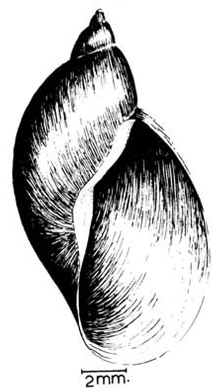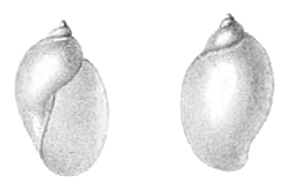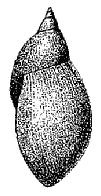Radix natalensis
Radix natalensis is a species of freshwater snail, an aquatic gastropod mollusc in the family Lymnaeidae.
| Radix natalensis | |
|---|---|
 | |
| This drawing of the apertural view of a shell of Radix natalensis shows one of the extreme shell forms of this species.[1] | |
| Scientific classification | |
| Kingdom: | |
| Phylum: | |
| Class: | |
| (unranked): | |
| Superfamily: | |
| Family: | |
| Subfamily: | Lymnaeinae |
| Genus: | |
| Species: | R. natalensis |
| Binomial name | |
| Radix natalensis | |
| Synonyms[2] | |
| |
This species occurs widely in Africa. It is a major intermediate host for Fasciola gigantica in Africa.[5][6] Placement of this species in the genus Radix was confirmed by Correa et al. (2010).[7]
Distribution
Radix natalensis is a widespread species in Africa, occurring from northern Africa to southern Africa:[2]
- Northern Africa: Algeria, Tunisia, Egypt, Sudan.[2] There are also findings of distribution of Radix natalensis in Algeria 8-10,000 years ago.[2]
- Western Africa: Benin, Burkina Faso, Côte d'Ivoire, Gambia, Ghana, Guinea, Guinea-Bissau, Liberia, Mali, Niger, Nigeria[2] and Senegal,[8]
- Eastern Africa: Burundi, Djibouti, Eritrea, Ethiopia, Kenya, Malawi, Mozambique, Somalia, Tanzania, Uganda, Zambia and Zimbabwe.[2]
- Central Africa: Angola, Cameroon, Central African Republic, Chad, Democratic Republic of the Congo, Republic of the Congo, Equatorial Guinea and Gabon.[2]
- Southern Africa: Botswana, Namibia, South Africa[2] and Rhodesia.[9]
- Madagascar[10]
The type locality is in "pools in Port Natal", which today is Durban, South Africa.[3]
Description
Radix natalensis was described by the German scientist and traveller Christian Ferdinand Friedrich Krauss in 1848.[3]
The shape of the shell is elongate ovoid.[11] The shell is colorless or light brown in color.[11] The height of the aperture covers about 3/4 of the shell height.[11] The lip of the aperture is thin and sharp.[11] The umbilicus is closed. The width of the shell is about 5.75–7 mm.[11] The height of the shell is 4.6-19.2 mm.[11]
 Drawing of apertural and abapertural view of the shell of Radix natalensis from its original description by Christian Ferdinand Friedrich Krauss in 1848. |
 Drawing of lateral view of the shell. |
The reproductive system and radula was described by Wright (1963) in detail.[11]
Ecology
Radix natalensis lives in permanent water bodies.[2] An estimated density of Radix natalensis in a natural habitat in Tanzania was 34 snails per m².[12] The snails lived mainly in the shallow water in depths of 0–4 cm, mainly between 20–30 cm from the shoreline.[12] They prefer plant detritus or bedrock as a substrate.[12]
Laboratory experiments have shown that some larger snails of Radix natalensis can survive on a wooden surface without water for up to 21 days.[9] Some smaller snails of Radix natalensis have survived desiccation on a soil surface up to 60 days on "black" soil.[9] Some smaller snails of Radix natalensis were able to survive for up to 90 days on soil among sedges (Cyperus) or in the "black" soil exposed to sun or in the soil with stones.[9]
Parasites of Radix natalensis include:
- Fasciola hepatica[6][7][13][14]
- Fasciola gigantica[5][7][15]
- Trichobilharzia sp.[16]
- some cercaria from Echinostomatidae[16]
- some xiphidiocercaria from Plagiorchiidae[16]
- four trematode larvae in Zambia[17]
Predators of Radix natalensis include leeches Helobdella nilae and Alboglossiphonia conjugata.[18]
Snails of the non-indigenous species Marisa cornuarietis eliminated Radix natalensis and other two native snail species from a small pond in Tanzania in an experiment in 1982.[19]
Oil extract of the gum myrrh Commiphora myrrha has molluscicidal activity against Radix natalensis.[20][21]
Phylogeny
A cladogram shows the phylogenic relations of species in the genus Radix:[7]
| Radix |
| ||||||||||||||||||||||||||||||||||||||||||||||||||||||||||||||||||
References
- Oberholzer G. & Van Eeden J. A. (1967). "The freshwater molluscs of the Kruger National Park". Koedoe. 10 (1): 1–42. doi:10.4102/koedoe.v10i1.762.
- Appleton C.; Ghamizi M.; Jørgensen A.; Kristensen T. K.; Stensgaard A-S.; Van Damme D. (2009). "Lymnaea natalensis". IUCN Red List of Threatened Species (2010.4 ed.). IUCN. OCLC 45139101. Retrieved 8 April 2011.
- (in German and Latin) Krauss F. (1848). Die Sudafrikanischen Mollusken. Ebnert & Seubert, Stuttgart, 140 pp, 6 plates. page 85, plate 5, figure 15.
- (in French) Bourguignat J. R. (1883). "Histoire malacogie de l'abyssinie". Annales Des Sciences Naturelles (Zoologie) (6)15: 1-162. 89, Plate 10, figs. 100-101.
- Soliman M. F. M. (2008). "Epidemiological review of human and animal fascioliasis in Egypt". The Journal of Infection in Developing Countries 2(3): 182-189. abstract. PDF
- Dar, Y.; Vignoles, P.; Rondelaud, D.; Dreyfuss, G. (2014). "Radix natalensis: the effect of Fasciola hepatica infection on the reproductive activity of the snail". Parasite. 21: 24. doi:10.1051/parasite/2014026.
- Correa, A. C.; Escobar, J. S.; Durand, P.; Renaud, F. O.; David, P.; Jarne, P.; Pointier, J. P.; Hurtrez-Boussès, S. (2010). "Bridging gaps in the molecular phylogeny of the Lymnaeidae (Gastropoda: Pulmonata), vectors of Fascioliasis". BMC Evolutionary Biology. 10: 381. doi:10.1186/1471-2148-10-381. PMC 3013105. PMID 21143890.
- (in French) Sarr A., Kinzelbach R. & Diouf M. (2011, in press). "Diversité spécifique et écologie des mollusques continenatux de la basse vallée du Ferlo (Sénégal). [Specific diversity and ecology of continental molluscs from the Lower Ferlo Valley (Senegal)]". MalaCo 7: 8 pp. PDF Archived 2 October 2011 at the Wayback Machine.
- Cridland, C. C. (1967). "Resistance of Bulinus (Physopsis) globosus, Bulinus (Ph.) africanus, Biomphalaria pfeifferi and Lymnaea natalensis to experimental desiccation". Bulletin of the World Health Organization. 36 (3): 507–513. PMC 2476301. PMID 5299680.
- Stothard, J. R.; Bremond, P.; Andriamaro, L.; Loxton, N. J.; Sellin, B.; Sellin, E.; Rollinson, D. (2000). "Molecular characterization of the freshwater snail Lymnaea natalensis (Gastropoda: Lymnaeidae) on Madagascar with an observation of an unusual polymorphism in ribosomal small subunit genes". Journal of Zoology. 252 (3): 303. doi:10.1111/j.1469-7998.2000.tb00625.x.
- Wright C. A. (1963). "The freshwater gastropod mollusca of Angola". Bulletin of the British Museum (Natural History) 10(8): 447-528. 16 plates. page 493.
- Utzinger, J.; Tanner, M. (2000). "Microhabitat preferences of Biomphalaria pfeifferi and Lymnaea natalensis in a natural and a man-made habitat in southeastern Tanzania". Memórias do Instituto Oswaldo Cruz. 95 (3): 287–294. doi:10.1590/S0074-02762000000300002. PMID 10800185.
- Dar, Y.; Djuikwo, T. F.; Vignoles, P.; Dreyfuss, G.; Rondelaud, D. (2010). "Radix natalensis (Gastropoda: Lymnaeidae), a potential intermediate host of Fasciola hepatica in Egypt" (PDF). Parasite (Paris, France). 17 (3): 251–256. doi:10.1051/parasite/2010173251. PMID 21073147.
- Dar, Y.; Vignoles, P.; Dreyfuss, G.; Rondelaud, D. (2010). "The development of rediae of Fasciola hepatica in Radix natalensis subjected twice to bimiracidial exposures". Journal of Helminthology. 85 (2): 1–5. doi:10.1017/S0022149X10000453. PMID 20822573.
- Dar, Y. D.; Rondelaud, D.; Dreyfuss, G. (2009). "Fasciola gigantica: Larval productivity of sheep-derived miracidia in Radix natalensis and Galba truncatula". Journal of the Egyptian Society of Parasitology. 39 (3): 837–847. PMID 20120750.
- Moema, E. B.; King, P. H.; Baker, C. (2008). "Cercariae developing in Lymnaea natalensis Krauss, 1848 collected in the vicinity of Pretoria, Gauteng Province, South Africa". The Onderstepoort Journal of Veterinary Research. 75 (3): 215–223. doi:10.4102/ojvr.v75i3.97. PMID 19040136.
- Phiri, A. M.; Phiri, I. K.; Chota, A.; Monrad, J. (2007). "Trematode infections in freshwater snails and cattle from the Kafue wetlands of Zambia during a period of highest cattle–water contact". Journal of Helminthology. 81 (1): 85–92. doi:10.1017/S0022149X07387786. PMID 17381873.
- Abd-Allah, K. F.; Saleh, M. H.; El-Hamshary, A. M.; Negm-Eldin, M. M.; El-Fakahany, A. F.; Abdel-Tawab, A. H.; Abdel-Maboud, A. I.; Aly, N. S. (2009). "Helobdella nilae and Alboglossiphonia conjugata leeches as biological agents for snails control". Journal of the Egyptian Society of Parasitology. 39 (1): 289–304. PMID 19530628.
- Nguma, J. F.; McCullough, F. S.; Masha, E. (1982). "Elimination of Biomphalaria pfeifferi, Bulinus tropicus and Lymnaea natalensis by the ampullarid snail, Marisa cornuarietis, in a man-made dam in northern Tanzania". Acta Tropica. 39 (1): 85–90. PMID 6122367.
- Massoud, A. M.; El-Shazly, A. M.; Nagaty, I. M.; Morsy, T. A. (2007). "Commiphora molmol extracts as plant molluscicide against Lymnaea natalensis". Journal of the Egyptian Society of Parasitology. 37 (2): 437–448. PMID 17985579.
- Abd-Allah, K. F.; Negm-Eldin, M. M.; Saleh, M. H.; El-Hamshary, A. M.; El-Gozamy, B. M.; Aly, N. S. (2009). "A study on biological control of six fresh water snails of medical and veterinary importance". Journal of the Egyptian Society of Parasitology. 39 (1): 121–139. PMID 19530615.
External links
| Wikimedia Commons has media related to Radix natalensis. |
- Siwela, A. H.; Nyathi, C. B.; Naik, Y. S. (2010). "A comparison of metal levels and antioxidant enzymes in freshwater snails, Lymnaea natalensis, exposed to sediment and water collected from Wright Dam and Lower Mguza Dam, Bulawayo, Zimbabwe". Ecotoxicology and Environmental Safety. 73 (7): 1728–1732. doi:10.1016/j.ecoenv.2010.08.001. PMID 20813407.
- Pilsbry H. A.; Bequaert J. C. (1927). "The aquatic mollusks of the Belgian Congo, with a geographical and ecological account of Congo malacology". Bulletin of the American Museum of Natural History. 53 (2): 69–602. hdl:2246/975. See pages 110, 111-114, 568.
